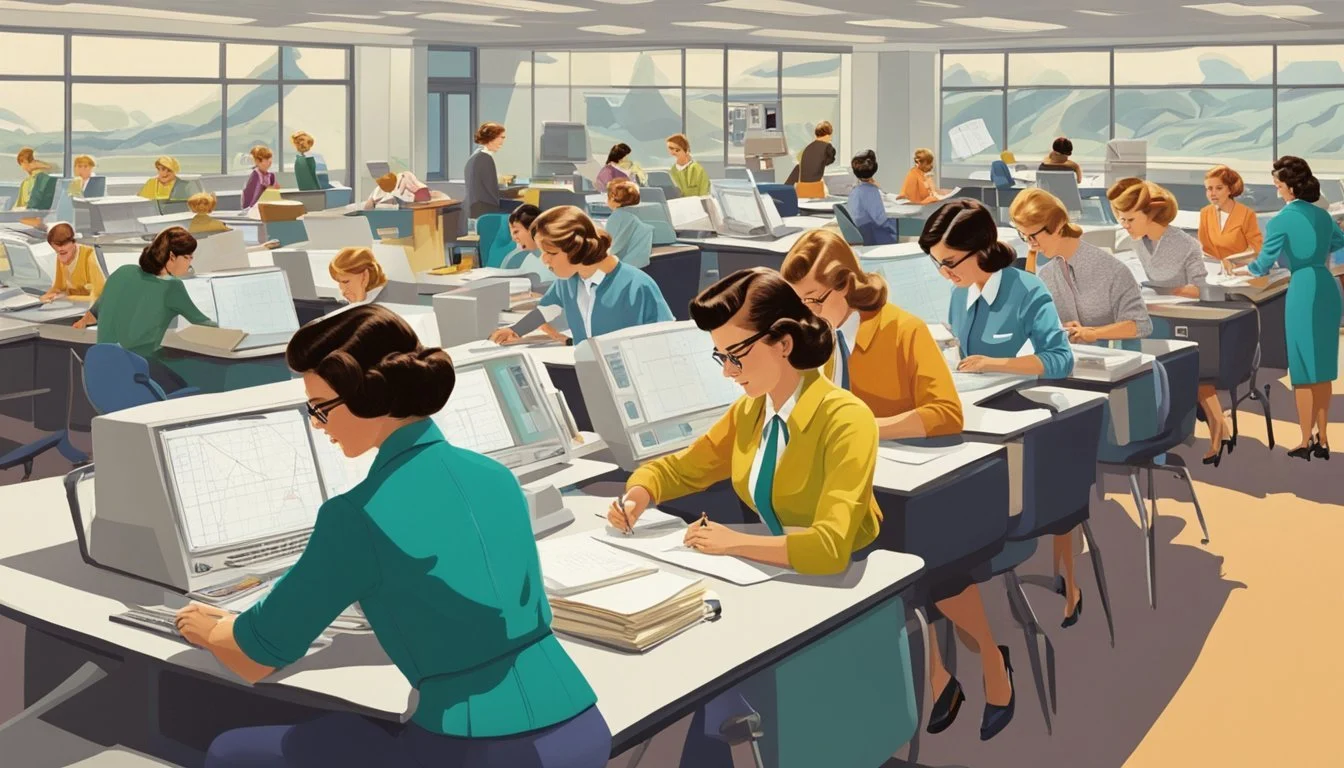Defying Expectations: The True Story of "Hidden Figures"
NASA's Unsung Heroes Revealed
In the early 1960s, as the United States raced to put a man in orbit, a group of talented African American women worked tirelessly behind the scenes at NASA. These mathematicians, known as "human computers," played a crucial role in America's space program despite facing racial and gender discrimination.
The film "Hidden Figures" brought to light the remarkable true story of Katherine Johnson, Dorothy Vaughan, and Mary Jackson, who made significant contributions to space exploration while breaking barriers in a male-dominated field. Their work included complex calculations for spacecraft trajectories, launch windows, and emergency return paths.
These women defied expectations and stereotypes, proving their intellectual prowess in a time when opportunities for African Americans and women in STEM fields were severely limited. Their story serves as an inspiration, highlighting the importance of diversity and inclusion in scientific advancement.
The Birth of 'Hidden Figures'
The story of African-American women mathematicians at NASA emerged from obscurity through meticulous research and a captivating book that caught Hollywood's attention.
Origins of the Story
Margot Lee Shetterly stumbled upon the hidden history of black female mathematicians while visiting her parents in Hampton, Virginia. Her father, a former NASA researcher, casually mentioned the contributions of these women. Intrigued, Shetterly began extensive research, uncovering a wealth of untold stories.
She conducted interviews with former "computers" and their families, delved into NASA archives, and examined historical records. Shetterly's investigation revealed the crucial role these women played in America's space race success.
Literary Adaptation
Shetterly's research culminated in the book "Hidden Figures: The American Dream and the Untold Story of the Black Women Mathematicians Who Helped Win the Space Race." Published in 2016, the book quickly gained attention for its compelling narrative and historical significance.
Hollywood took notice, and the film rights were acquired before the book's release. Screenwriters Allison Schroeder and Theodore Melfi adapted Shetterly's work for the big screen. They focused on three key figures: Katherine Johnson, Dorothy Vaughan, and Mary Jackson.
The film's development moved swiftly, with casting announcements generating buzz. Taraji P. Henson, Octavia Spencer, and Janelle Monáe were chosen to portray the lead roles.
Profiles in Courage and Intellect
Katherine Johnson, Dorothy Vaughan, and Mary Jackson exemplified exceptional courage and intellect at NASA. These pioneering women overcame racial and gender barriers to make significant contributions to the space program during a pivotal era in American history.
Katherine Johnson's Journey
Katherine Johnson's mathematical brilliance shone through her work at NASA. Born in 1918, she showed an early aptitude for numbers and graduated from college at just 18 years old.
At NASA, Johnson calculated flight trajectories for crucial missions, including John Glenn's orbital flight and the Apollo 11 moon landing. Her precise computations were vital to the success of these historic endeavors.
Johnson's expertise was so respected that John Glenn specifically requested she verify the computer calculations before his flight. Her work earned her the Presidential Medal of Freedom in 2015, recognizing her groundbreaking achievements in space exploration.
Dorothy Vaughan's Leadership
Dorothy Vaughan demonstrated remarkable leadership skills during her tenure at NASA. She became the first African American woman to supervise a group of staff at the agency.
Vaughan led the West Area Computing Unit, a segregated group of African American women mathematicians. Recognizing the future importance of electronic computers, she taught herself and her staff programming languages.
This foresight ensured her team's relevance as NASA transitioned to machine computers. Vaughan's adaptability and commitment to her colleagues' success exemplified her strong leadership and vision for the future of space technology.
Mary Jackson's Pioneering Spirit
Mary Jackson's determination led her to become NASA's first African American female engineer. She faced numerous obstacles but persevered to achieve her goals.
To qualify for the engineering program, Jackson needed to take graduate-level math and physics courses at a segregated high school. She petitioned the City of Hampton to allow her to attend classes with white students.
Jackson completed the courses and earned her promotion to engineer in 1958. Throughout her career, she authored numerous research reports and worked to improve women's opportunities at NASA.
Her pioneering spirit paved the way for future generations of women and minorities in STEM fields.
Contextualizing 'Hidden Figures'
The story of "Hidden Figures" unfolds against a backdrop of profound social and technological change in 1960s America. Racial segregation, gender discrimination, and the intense competition of the Space Race all shaped the experiences of the African American women mathematicians at NASA.
Racial and Gender Barriers
In the 1960s, Jim Crow laws still enforced racial segregation in the American South. African Americans faced discrimination in education, employment, and public spaces. At NASA's Langley Research Center in Virginia, Black women mathematicians worked in segregated facilities.
They used separate bathrooms and dining areas from their white colleagues. Despite their crucial contributions, these women often went uncredited for their work. The computing pool where many worked was racially segregated until 1958.
Gender barriers compounded racial discrimination. Women in STEM fields were rare, and those present often faced skepticism about their abilities. They had to prove themselves repeatedly in a male-dominated environment.
The Space Race Era
The Cold War rivalry between the United States and Soviet Union fueled rapid advancements in space technology. After the Soviet Union launched Sputnik 1 in 1957, the U.S. scrambled to catch up.
NASA was established in 1958 to lead American space efforts. The agency recruited talent from all available sources, including African American women with math skills. These "human computers" performed complex calculations essential for space missions.
Key events of the era included:
1961: Yuri Gagarin becomes the first human in space
1962: John Glenn orbits Earth
1969: Apollo 11 moon landing
Technological Advancements
The 1960s saw rapid progress in computing technology, changing the nature of mathematical work at NASA. Early in the decade, most calculations were done by hand or with mechanical calculators.
As electronic computers became more powerful, the role of human computers evolved. Many, like Dorothy Vaughan, learned programming languages to adapt to these changes. IBM mainframes gradually took over tasks previously done manually.
Space technology drove innovations in:
Rocket propulsion
Guidance systems
Heat shields
Communication satellites
These advancements had wide-ranging impacts beyond the space program, influencing fields from telecommunications to materials science.
Cinematic Triumph
"Hidden Figures" transformed from an untold story into a box office sensation, captivating audiences worldwide. The film's journey from concept to screen, its stellar cast, and critical acclaim all contributed to its remarkable success.
From Script to Screen
Theodore Melfi and Allison Schroeder adapted Margot Lee Shetterly's book into a compelling screenplay. They faced the challenge of condensing decades of history into a two-hour film while maintaining historical accuracy. The writers focused on key moments and characters to create a narrative that resonated with viewers.
Producers Donna Gigliotti, Peter Chernin, and Jenno Topping recognized the story's potential and secured funding. 20th Century Fox greenlit the project, allocating a $25 million budget. Filming took place in Atlanta, Georgia, doubling for 1960s Virginia.
Director Theodore Melfi brought the script to life, balancing historical details with emotional depth. He emphasized the women's personal struggles alongside their professional achievements.
Casting the Leads
The film's success hinged on finding the perfect actresses to portray the brilliant mathematicians. Taraji P. Henson took on the role of Katherine Johnson, bringing her sharp wit and emotional range to the character. Octavia Spencer embodied Dorothy Vaughan's determination and leadership as the unofficial supervisor.
Janelle Monáe rounded out the trio as Mary Jackson, infusing the role with energy and ambition. The chemistry between the three leads was palpable, creating a believable friendship on screen.
Supporting roles were filled by established actors like Kevin Costner, Kirsten Dunst, and Jim Parsons, adding depth to the NASA environment.
Critical Reception
"Hidden Figures" premiered to widespread acclaim from critics and audiences alike. The film earned a 93% approval rating on Rotten Tomatoes, with praise for its inspiring story and strong performances.
Box office success followed, with the film grossing over $236 million worldwide against its $25 million budget. It became the highest-grossing Best Picture nominee at the 89th Academy Awards.
The film received numerous accolades, including three Oscar nominations for Best Picture, Best Supporting Actress (Octavia Spencer), and Best Adapted Screenplay. It won the Screen Actors Guild Award for Outstanding Performance by a Cast in a Motion Picture.
Critics lauded the film's ability to educate and entertain, shedding light on an overlooked chapter of American history. Many praised its positive portrayal of African American women in STEM fields.
Cultural and Educational Impact
"Hidden Figures" has profoundly influenced society's perception of women and minorities in STEM fields. The film and book have sparked important conversations about diversity and inclusion in scientific pursuits.
Inspiring Future Generations
"Hidden Figures" has become a catalyst for encouraging young women and people of color to pursue careers in science and mathematics. Schools across the United States have incorporated the story into their curricula, using it to teach history, science, and social studies.
Many organizations have developed programs inspired by the film, offering STEM workshops and mentorship opportunities to underrepresented groups. These initiatives aim to break down barriers and create pathways for diverse talent in scientific fields.
The story has also led to increased recognition of other overlooked contributions by women and minorities throughout history, prompting further research and acknowledgment of their achievements.
Ongoing Relevance
The themes explored in "Hidden Figures" continue to resonate in today's society. The film has sparked discussions about workplace diversity and equal opportunities in STEM industries.
Companies and institutions have been prompted to examine their hiring practices and workplace cultures, leading to new diversity initiatives and policies. The story serves as a reminder of the importance of creating inclusive environments that foster innovation and utilize all available talent.
"Hidden Figures" has also contributed to a broader cultural shift, challenging stereotypes and promoting a more accurate representation of women and minorities in media and popular culture. This increased visibility has helped to reshape public perceptions and expectations.
Legacy and Honors
The women of "Hidden Figures" left an indelible mark on history, earning long-overdue recognition for their contributions to space exploration and civil rights. Their story has inspired generations and reshaped public understanding of NASA's early achievements.
Awards and Accolades
Katherine Johnson received the Presidential Medal of Freedom in 2015, the highest civilian honor in the United States. In 2019, she was awarded the Congressional Gold Medal, along with her colleagues Dorothy Vaughan, Mary Jackson, and Christine Darden. NASA renamed facilities in their honor, with the Katherine Johnson Computational Research Facility dedicated in 2017.
The film "Hidden Figures" garnered numerous accolades, including three Academy Award nominations. It won the Screen Actors Guild Award for Outstanding Performance by a Cast in a Motion Picture in 2017.
Historical Recognition
The legacy of these pioneering women extends beyond awards. Their story sparked renewed interest in the contributions of African American women to STEM fields. Universities and organizations established scholarships in their names to support underrepresented students in science and mathematics.
NASA implemented diversity initiatives inspired by their achievements. The agency now actively promotes inclusivity in its workforce and educational outreach programs. Museums and educational institutions feature exhibits highlighting their work, ensuring their place in history is permanently acknowledged.
Their story continues to inspire books, documentaries, and educational programs, cementing their status as role models for future generations of scientists and mathematicians.
Conclusion
"Hidden Figures" sheds light on the remarkable contributions of African American women to NASA's space program. Katherine Johnson, Dorothy Vaughan, and Mary Jackson overcame significant barriers of racism and sexism to achieve groundbreaking success.
Their story demonstrates the power of perseverance, intellect, and courage in the face of adversity. These women played crucial roles in America's space race achievements, including John Glenn's historic orbit of Earth.
The film and book have brought well-deserved recognition to these pioneering mathematicians and engineers. Their legacy continues to inspire new generations of women and minorities in STEM fields.
"Hidden Figures" serves as a reminder of the importance of diversity and inclusion in scientific endeavors. It highlights how talent and brilliance can emerge from unexpected places when given the opportunity to flourish.
The impact of Johnson, Vaughan, and Jackson extends far beyond their individual accomplishments. Their story emphasizes the need to recognize and celebrate the often overlooked contributions of marginalized groups throughout history.







